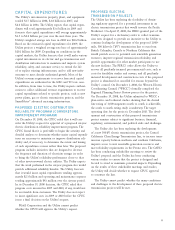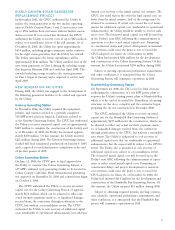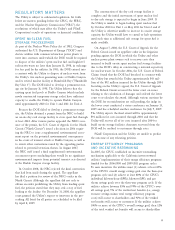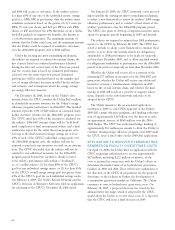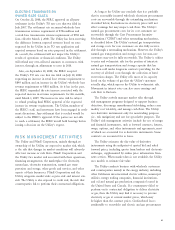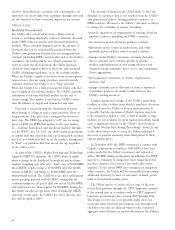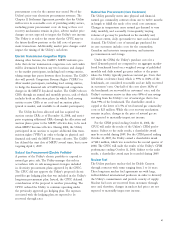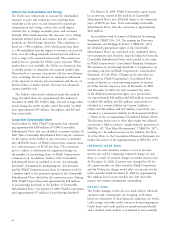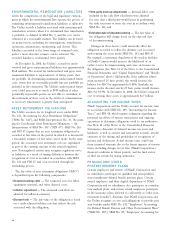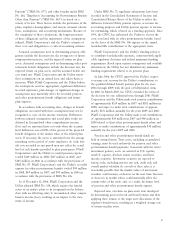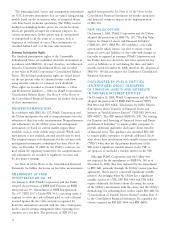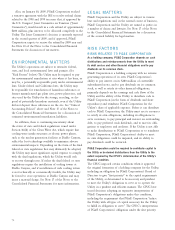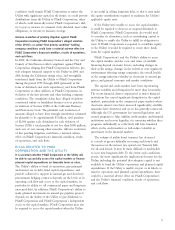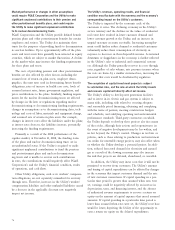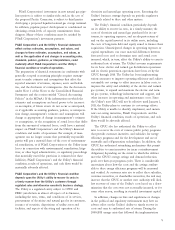PG&E 2008 Annual Report Download - page 67
Download and view the complete annual report
Please find page 67 of the 2008 PG&E annual report below. You can navigate through the pages in the report by either clicking on the pages listed below, or by using the keyword search tool below to find specific information within the annual report.
65
enterprise expects to incur in the future are being recovered
through current rates, SFAS No. 71 requires that the regu-
lated enterprise record those expected future costs as regula-
tory liabilities. In addition, amounts that are probable of
being credited or refunded to customers in the future must
be recorded as regulatory liabilities. Regulatory assets and
liabilities are recorded when it is probable, as defi ned in
SFAS No. 5, “Accounting for Contingencies” (“SFAS No. 5”),
that these items will be recovered or refl ected in future rates.
Determining probability requires signifi cant judgment on
the part of management and includes, but is not limited to,
consideration of testimony presented in regulatory hearings,
proposed regulatory decisions, fi nal regulatory orders, and
the strength or status of applications for rehearing or
state court appeals. The Utility also maintains regulatory
balancing accounts, which comprise sales and cost balancing
accounts. These balancing accounts are used to record the
differences between revenues and costs that can be recovered
through rates.
If the Utility determined that it could not apply SFAS
No. 71 to its operations or, if under SFAS No. 71, it could
not conclude that it is probable that revenues or costs would
be recovered or refl ected in future rates, the revenues or
costs would be charged to income in the period in which
they were incurred. If it is determined that a regulatory asset
is no longer probable of recovery in rates, then SFAS No. 71
requires that it be written off at that time. At December 31,
2008, PG&E Corporation and the Utility reported regulatory
assets (including current regulatory balancing accounts
receivable) of approximately $7.2 billion and regulatory
liabilities (including current balancing accounts payable)
of approximately $4.4 billion.
CRITICAL ACCOUNTING POLICIES
The preparation of Consolidated Financial Statements in
accordance with GAAP involves the use of estimates and
assumptions that affect the recorded amounts of assets and
liabilities as of the date of the fi nancial statements and
the reported amounts of revenues and expenses during the
reporting period. The accounting policies described below
are considered to be critical accounting policies, due, in part,
to their complexity and because their application is relevant
and material to the fi nancial position and results of opera-
tions of PG&E Corporation and the Utility, and because
these policies require the use of material judgments and
estimates. Actual results may differ substantially from these
estimates. These policies and their key characteristics are
outlined below.
REGULATORY ASSETS AND LIABILITIES
The Utility accounts for the fi nancial effects of regulation
in accordance with SFAS No. 71, “Accounting for the Effects
of Certain Types of Regulation” (“SFAS No. 71”). SFAS
No. 71 applies to regulated entities whose rates are designed
to recover the cost of providing service. SFAS No. 71
applies to all of the Utility’s operations.
Under SFAS No. 71, incurred costs that would otherwise
be charged to expense may be capitalized and recorded
as regulatory assets if it is probable that the incurred costs
will be recovered in future rates. The regulatory assets are
amortized over future periods consistent with the inclusion
of costs in authorized customer rates. If costs that a regulated
The Utility ties many energy contracts to master agreements that require security (referred to as “credit collateral”) in the
form of cash, letters of credit, corporate guarantees of acceptable credit quality, or eligible securities if current net receivables
and replacement cost exposure exceed contractually specifi ed limits.
The following table summarizes the Utility’s net credit risk exposure to its wholesale customers and counterparties, as well
as the Utility’s credit risk exposure to its wholesale customers or counterparties with a greater than 10% net credit exposure,
at December 31, 2008 and December 31, 2007:
Net
Number of Exposure to
Gross Credit Wholesale Wholesale
Exposure Customers or Customers or
Before Credit Credit Net Credit Counterparties Counterparties
(in millions) Collateral(1) Collateral Exposure(2) >10% >10%
December 31, 2008 $240 $84 $156 2 $107
December 31, 2007 $311 $91 $220 2 $111
(1) Gross credit exposure equals mark-to-market value on fi nancially settled contracts, notes receivable, and net receivables (payables) where netting is
contractually allowed. Gross and net credit exposure amounts reported above do not include adjustments for time value or liquidity.
(2) Net credit exposure is the gross credit exposure minus credit collateral (cash deposits and letters of credit). For purposes of this table, parental guarantees
are not included as part of the calculation.


